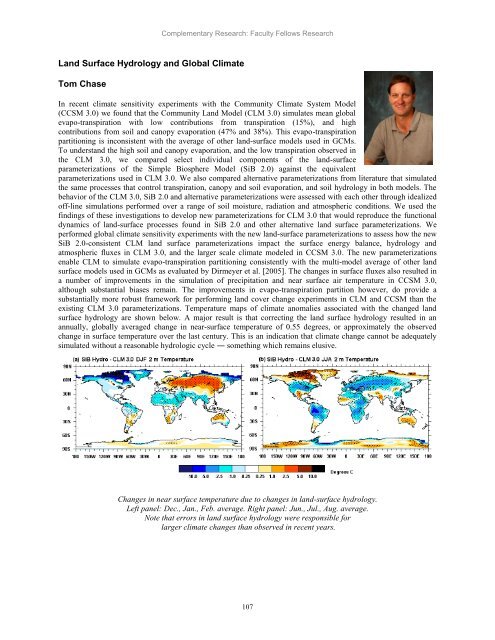Scientific Theme: Advanced Modeling and Observing Systems
Scientific Theme: Advanced Modeling and Observing Systems
Scientific Theme: Advanced Modeling and Observing Systems
Create successful ePaper yourself
Turn your PDF publications into a flip-book with our unique Google optimized e-Paper software.
L<strong>and</strong> Surface Hydrology <strong>and</strong> Global Climate<br />
Tom Chase<br />
Complementary Research: Faculty Fellows Research<br />
In recent climate sensitivity experiments with the Community Climate System Model<br />
(CCSM 3.0) we found that the Community L<strong>and</strong> Model (CLM 3.0) simulates mean global<br />
evapo-transpiration with low contributions from transpiration (15%), <strong>and</strong> high<br />
contributions from soil <strong>and</strong> canopy evaporation (47% <strong>and</strong> 38%). This evapo-transpiration<br />
partitioning is inconsistent with the average of other l<strong>and</strong>-surface models used in GCMs.<br />
To underst<strong>and</strong> the high soil <strong>and</strong> canopy evaporation, <strong>and</strong> the low transpiration observed in<br />
the CLM 3.0, we compared select individual components of the l<strong>and</strong>-surface<br />
parameterizations of the Simple Biosphere Model (SiB 2.0) against the equivalent<br />
parameterizations used in CLM 3.0. We also compared alternative parameterizations from literature that simulated<br />
the same processes that control transpiration, canopy <strong>and</strong> soil evaporation, <strong>and</strong> soil hydrology in both models. The<br />
behavior of the CLM 3.0, SiB 2.0 <strong>and</strong> alternative parameterizations were assessed with each other through idealized<br />
off-line simulations performed over a range of soil moisture, radiation <strong>and</strong> atmospheric conditions. We used the<br />
findings of these investigations to develop new parameterizations for CLM 3.0 that would reproduce the functional<br />
dynamics of l<strong>and</strong>-surface processes found in SiB 2.0 <strong>and</strong> other alternative l<strong>and</strong> surface parameterizations. We<br />
performed global climate sensitivity experiments with the new l<strong>and</strong>-surface parameterizations to assess how the new<br />
SiB 2.0-consistent CLM l<strong>and</strong> surface parameterizations impact the surface energy balance, hydrology <strong>and</strong><br />
atmospheric fluxes in CLM 3.0, <strong>and</strong> the larger scale climate modeled in CCSM 3.0. The new parameterizations<br />
enable CLM to simulate evapo-transpiration partitioning consistently with the multi-model average of other l<strong>and</strong><br />
surface models used in GCMs as evaluated by Dirmeyer et al. [2005]. The changes in surface fluxes also resulted in<br />
a number of improvements in the simulation of precipitation <strong>and</strong> near surface air temperature in CCSM 3.0,<br />
although substantial biases remain. The improvements in evapo-transpiration partition however, do provide a<br />
substantially more robust framework for performing l<strong>and</strong> cover change experiments in CLM <strong>and</strong> CCSM than the<br />
existing CLM 3.0 parameterizations. Temperature maps of climate anomalies associated with the changed l<strong>and</strong><br />
surface hydrology are shown below. A major result is that correcting the l<strong>and</strong> surface hydrology resulted in an<br />
annually, globally averaged change in near-surface temperature of 0.55 degrees, or approximately the observed<br />
change in surface temperature over the last century. This is an indication that climate change cannot be adequately<br />
simulated without a reasonable hydrologic cycle ― something which remains elusive.<br />
Changes in near surface temperature due to changes in l<strong>and</strong>-surface hydrology.<br />
Left panel: Dec., Jan., Feb. average. Right panel: Jun., Jul., Aug. average.<br />
Note that errors in l<strong>and</strong> surface hydrology were responsible for<br />
larger climate changes than observed in recent years.<br />
107
















